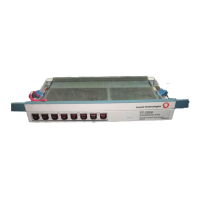Administration and Provisioning
Issue 8.0 July 2002
8-135
values (1 to 255) indicate that the local network element exchanges
remote status information with all other network elements that have
the same value for the alarm group parameter.
— The Alarm Gateway Network Element (AGNE) parameter
(Release 6 and later) specifies whether the local element will serve
the other network elements in the alarm group as the AGNE. More
than one AGNE may be provisioned for a SONET subnetwork.
— When Release 6 of the FT-2000 OC-48 ADR Terminal interworks
with Release 7.2 of the DDM-2000 OC-3 Multiplexer in subnetworks
with less than 16 network elements, the same network element may
serve as the AGNE and the TL1 gateway network element.
!
CAUTION:
In subnetworks with more than 16 NEs, the NE serving as the AGNE
CANNOT serve as the TL1 gateway NE, nor can it serve as the
DS-NE.
The AGNE, TL1 gateway NE, as well as the DS-NE
functions must be distributed (i.e., at three separate NEs in the
subnetwork)
.
— The TL1 Gateway parameter (CIT provisionable in Release 4.1
only) specifies (“Yes” or “No”) whether the NE is a TL1 gateway
network element (GNE). There can be one or more TL1 GNEs in the
ring. The TL1 GNE serves as a single interface to the local X.25
message-based operations system for all the NEs in the ring. In
Release 6 and later releases, the FT-2000 OC-48 ADR Terminal can
also act as a TL1 GNE for other network elements in the SONET
subnetwork (for example, a DDM-2000 Multiplexer) via the OC-3
DCC.
When Release 6 of the FT-2000 OC-48 ADR Terminal interworks
with the DDM-2000 OC-3 Multiplexer, the recommended maximum
subnetwork size is 24 NEs. When Release 7 of the FT-2000 OC-48
ADR Terminal interworks with the DDM-2000 OC-3 Multiplexer, the
recommended maximum subnetwork size is 32 NEs.
!
CAUTION:
In subnetworks with more than 16 NEs, the NE serving as the TL1
gateway NE CANNOT serve as the AGNE. Neither can it serve as
the DS-NE.
TheAGNE,TL1gatewayNE,aswellastheDS-NE
functions must be distributed (i.e., at three separate NEs in the
subnetwork).
■ SECURITY-Set-Password (TL1 = ED-PID): This input changes your
password.
— The Old Password parameter must match the user's current
password.

